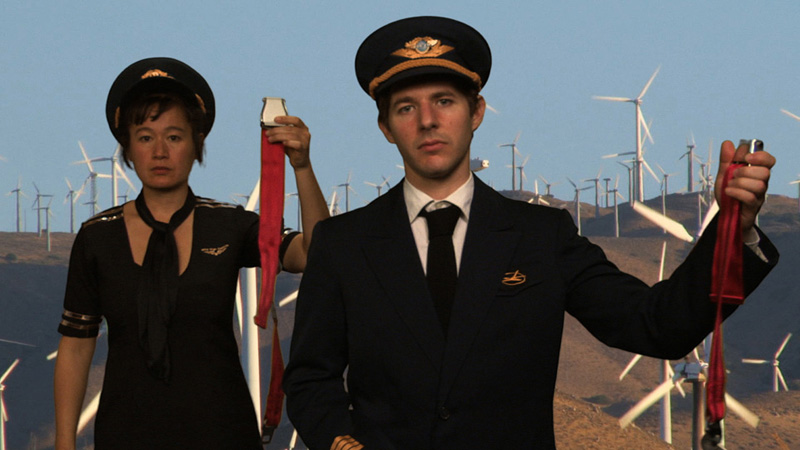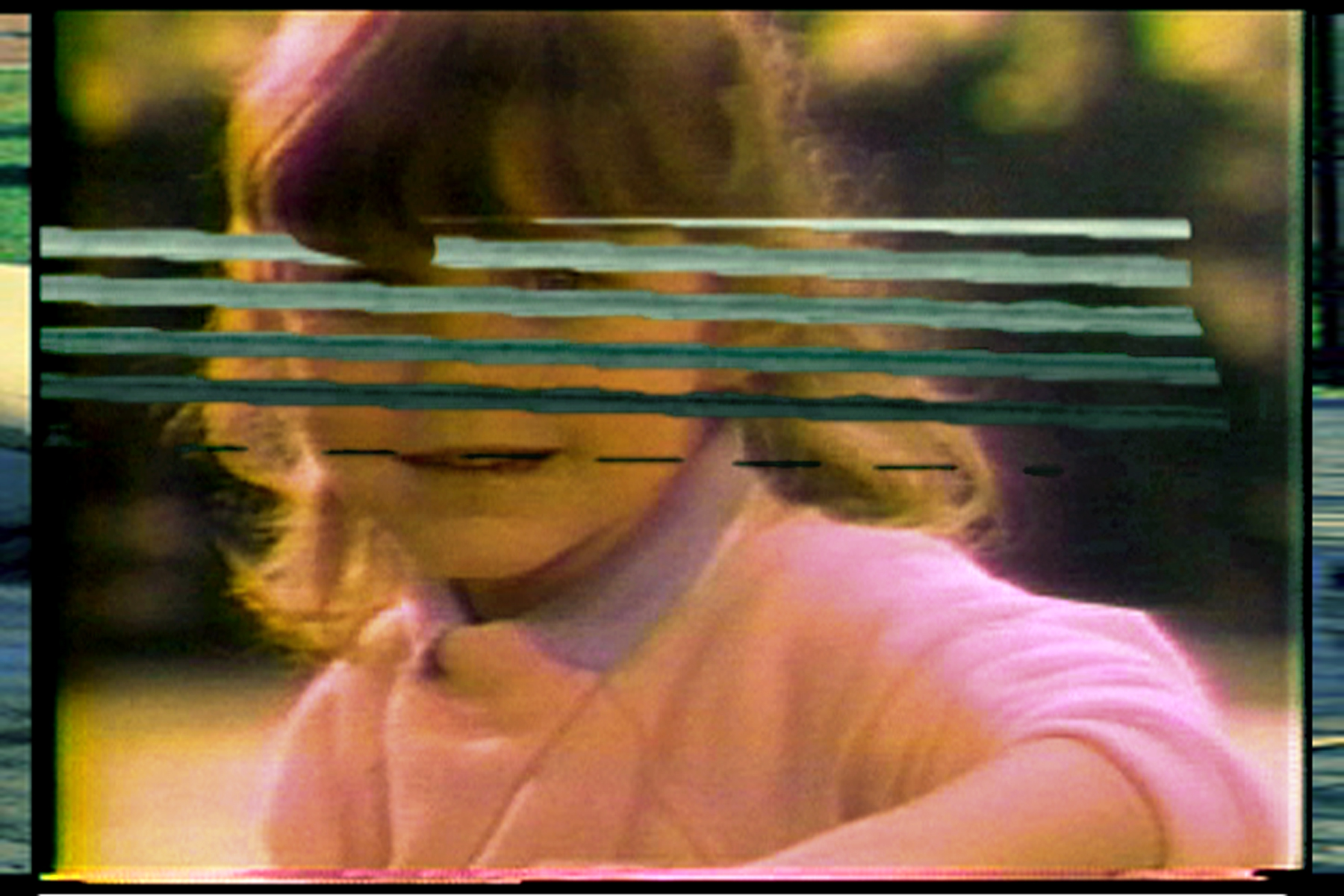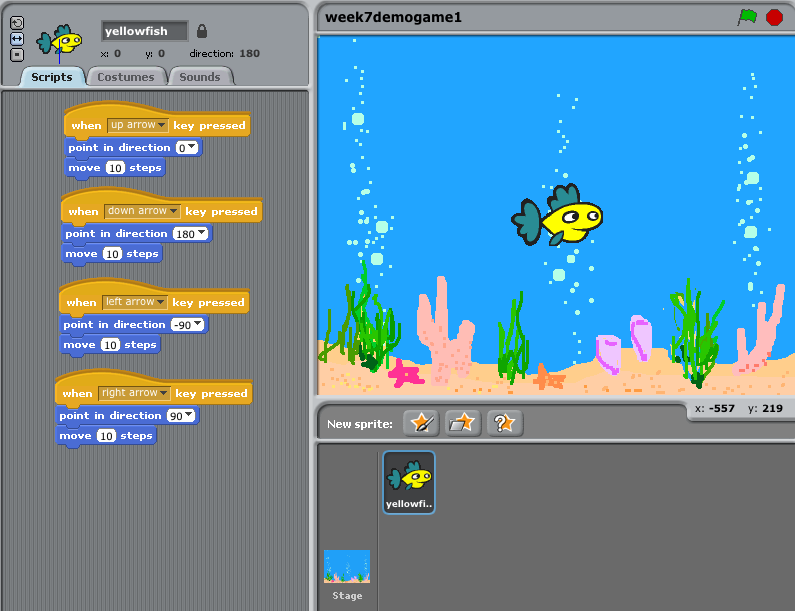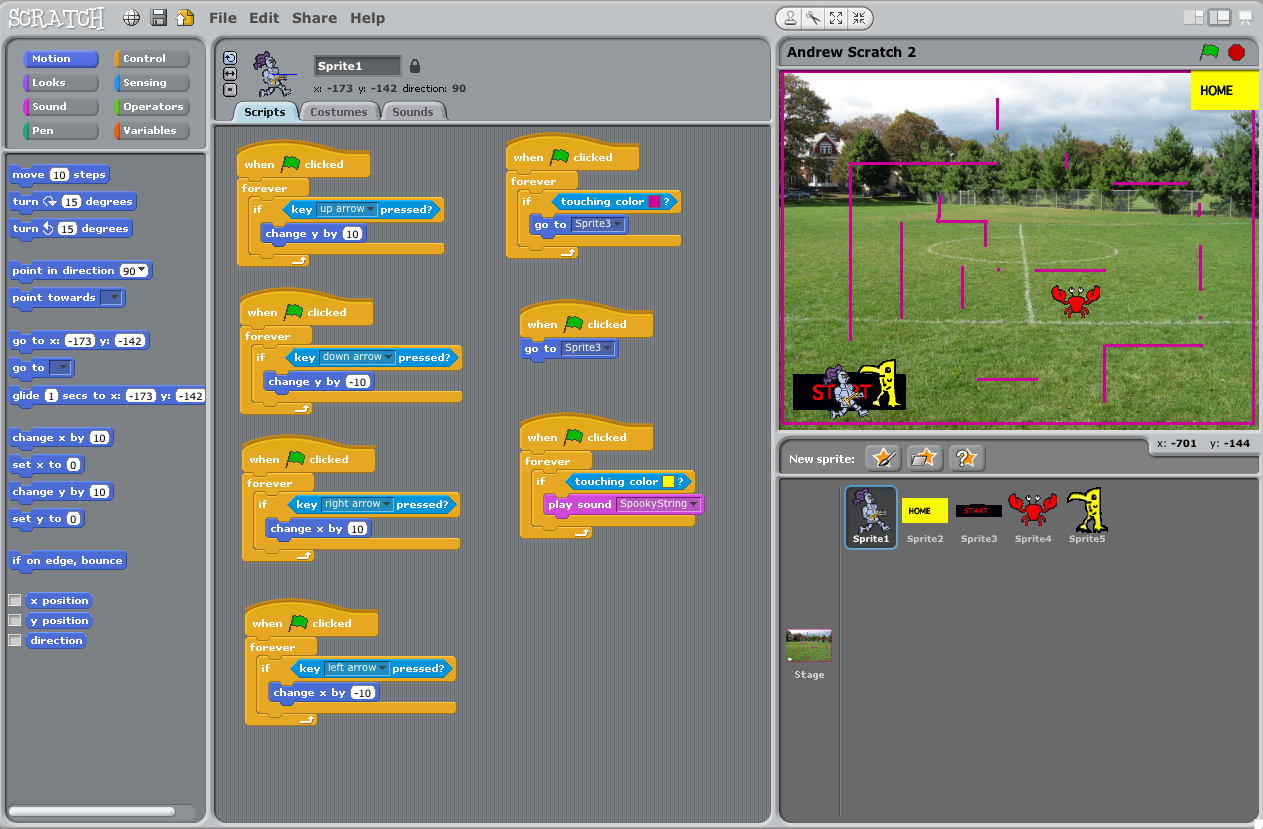A New Culture of Learning Response
The opening of this book is very optimistic. It shows the positive aspect of how technology is such a fundamental part of people's lives today. I liked how the author described learning about computers and programming as "fun". Sam's story was a prime example of how children today are learning from a young age the usage and knowledge of computers and programs and other social aspects. For example, the game Scratch that students from MIT created allows kids to learn about programming, which being a computer science major myself, is not the easiest thing to pick up. However, this is giving opportunities to people at a young age. The impact that this may have on the future is huge. The technological advances are unkown for the fact that if children are learning so much about computers and social media at a young age, it can effect how communication will progress in the future. Also, it allows children to "play" while learning and this is probably one of the most effective strategies. By taking this route, we may be able to achieve more and more. For example, it gives us more unique ideas: the ideas of children.
The Work of Art in the Age of Mechanical Reproduction Part VII Response
This section discussed the dispute of photography and film. Walter Benjamin makes the point, "When the age of mechanical reproduction separated art from its basis in cult, the semblance of its autonomy disappeared forever". I do see some truth in this; we went from a time when everything was done by hand and you had original paintings and mimics of those paintings to a time where we can make copies of everything and digitalize it. However I do think that even though we can accomplish and change images through electronics, I believe that there is still autonomy. It has given people a chance to capture moments in their life that will only happen once. Everyone can use a paintbrush or camera (to take photos and film), but not everyone can give it that spark that makes an assortment of people know it's special. I do not think there are specific guidelines for what is considered "art"--the term is so broad, one can narrow it down into categories (paintings, photography, film, drawings, sculpture, etc.) but I think that if the object in question can pull a feeling from someone, it can be considered art to a degree.
No Logo Response
I think culture-jamming will always be relevant, but only to a group of people. I think as far as artists go, they always want to send a message across one way or another, but they will do that in their own style, and that may not involve culture-jamming. Culture-jamming can definitely have a great impact, however, as someone from a small town, something like culture-jamming doesn’t have a significant impact on the thoughts and ideas of the people.
I think that it is most powerful when involving politics or a controversial topic. In order to make an impact, which I think is every artists goal, it needs to “hit home” for people; it needs to be about a topic that many people are invested in. I do think that culture-jamming is relevant, just not as relevant as it could be. However, as said in the article, the use of technology may change the way the game is played.
The internet is already a big part of society and has the ability to reach people of all different ages and interests. By using the internet, culture-jamming may have a chance to really spread, but it also has the possibility of losing its impact; even by a change in scale, that can have a dramatic impact of a piece of art. The internet is a fast way to spread something, however it is also a place where a piece of art can easily get lost.
Artist Post
If any of you are familiar with “POGO” from YouTube, then it means you know Nick Bertke. Bertke is an electronic music artist whose work consists of recording small sounds from specific scenes of movies and then sequencing the sounds together in order to make a new piece of music. Bertke has made many videos, including videos of Alice in Wonderland, Toy Story, Harry Potter, Cinderella, and more. According to internet sources, Bertke was arrested and taken into custody during his September 2011 tour “due to the lack of a proper work visa. He is now prohibited from re-entering the United States for 10 years”. There is surprisingly not much information on Burtke, but here is his POGO website:
http://pogomix.net/
The reason why I am looking into Burtke is because I am doing a Disney video. While it is not of the same format, I am looking into specific scenes, listening carefully to words, and trying to find the right rhythm for my video. Burtke is a very talented video artist who I think many people can receive inspiration from.
The second artist that I am going to write about is an artist by the name of Yoshitaka Amano. I came across Amano when looking for my second artist. Amano was born I Shizuoka, Japan. Amano is a character designer, illustrator, and animator and is most known for his character art. His first paid project was for Speed Racer. Amano has since become a freelancer and has been hired for many projects from anime to video games.
Amano has been a character designer for anime shows like Time Bokan, Gatchaman, Tekkaman, and Honey Bee (if anyone is familiar with those). Something that more people might be familiar with are the Final Fantasy games. Amano is best known for developing as well as designing the conceptual work for the Final Fantasy games. Being familiar with Final Fantasy myself, I was very excited to come across Amano in my artist search. I think it would be interesting to do a project that somehow involves something similar to Amano's works.
“Since the 1990s[,] Amano has been creating and exhibiting paintings featuring his iconic retro pop icons in galleries around the world, primarily painting on aluminum box panels with acrylic and automotive paint” (Wikipedia). Amano has been influenced by early Western comic books, art nouveau, and Japanese woodblock prints. Amano has been interested in drawing from a young age and has successfully made his passion into his profession. I personally enjoy Amano's style because it gives the sense that it is being "drawn". I really like work where you feel as though you can see each line that has created a beautiful image. I also think that Amano chooses a variety of colors for his work which helps set his work apart. Amano has a variety of works and is a very exciting artist to look at.
Here are some of Amano’s photos:
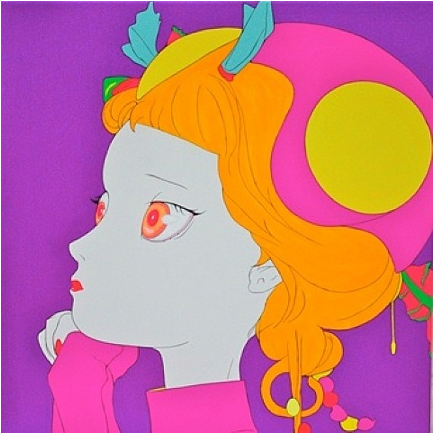
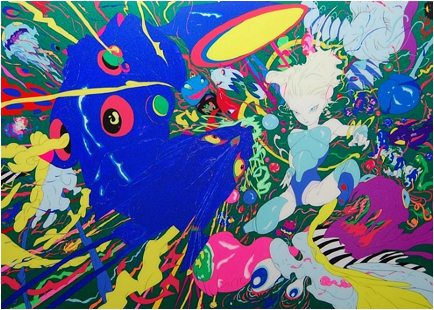
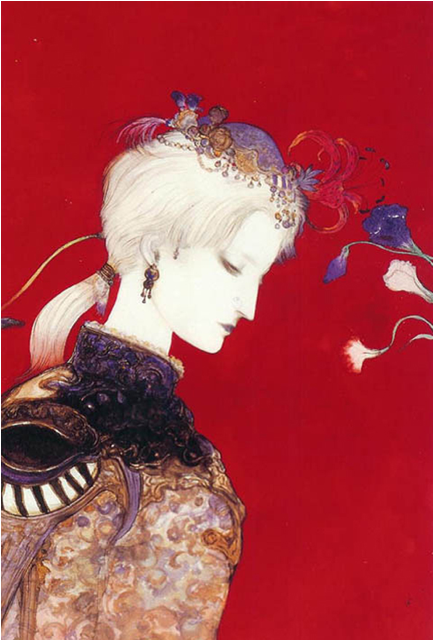
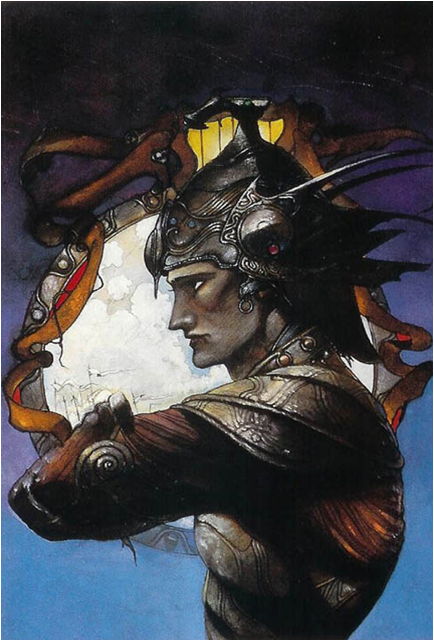
These are two sites that has some of Amano’s work:
http://comicblog.septagonstudios.com/the-inspirational-artwork-of-yoshitaka-amano/
http://www.elevenland.com/amano/amano.php3
Artist Research Post
Ross Ashton is a projection artist. Ashton was trained in photography and theatre before he moved to London and started to work in video and slide projection. Ashton spent four years in Paris doing work with a variety of visual media before he began to concentrate in High Power Projection in 1992. In time, Ashton created a reputation for himself by accomplishing amazing pieces that show an “understanding of the relationship between artwork and structure, light and surface, object and subject” (http://rossashton.com/About/about.html). Ashton has done impressive work with the FIFA Football World Cup, the Pittsburgh Festival of Lights, Cambridge 800, London New Years Eve, the Queens Golden Jubilee, and more. Being invited to do work at such spectacular events prove his skills and make him very interesting to follow.
To get into detail about a few of Ashton’s pieces, Ashton did a projection onto the South Transept of York Minster in 2010 for the Illuminating York Festival. This projection was called “Rose” and it was divided into four sections over four days: the first was meant to focus on the rose as the symbol of Yorkshire, the second was the “Rose Garden” that combined love poetry that was spoken by volunteers and showed images of climbing rose trees. The third section was called “Mary” that took images of the Virgin Mary and the York Minster choir singing. The final part was “a study of perfection” (http://www.rossashton.com/Projects/ROSE/rose.html) which took geometrical shapes and patterns as well as stained glass imagery with glass sounds.
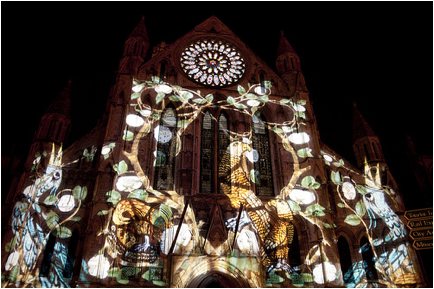
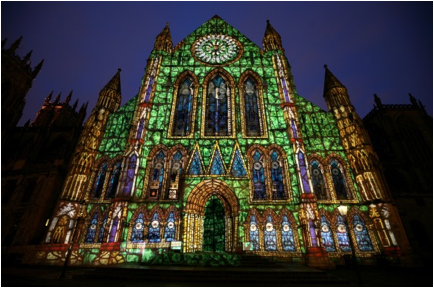
Ashton also had the opportunity to create a piece for the Lumiere Festival at Durham Cathedral called “Crown of Light”. Ashton was commissioned to make a projection that would show Durham Cathedrals rich heritage as well as its history. Most of the imagery was from the Lindisfarne Gaspels dating back from the seventh century. Ashton did not want any shadows coming from the multitude of trees in the surrounding image area. In order to accomplish this however, Ashton needed six separate projection positions using four different lenses. Luckily, the hard work paid off and Ashton was able to create a beautiful piece.
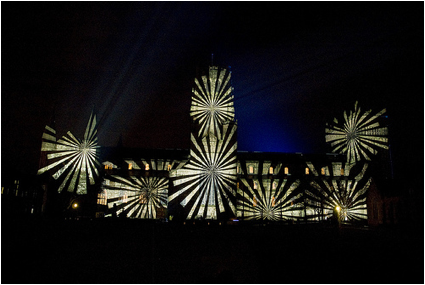
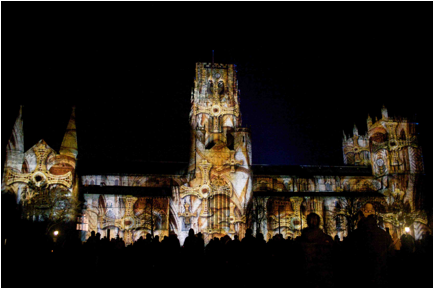
My second artist is Fred Eerdekens. Eerdekens is a Belgian artist who makes use of sculptures and installations to create shadow imagery. By positioning object in a certain way, at a certain distance, Eerdekens shows that he completely understands the delicateness of shadows. Eerdekens’s shadows are given an amazing representation by taking simple things and creating new works of art through shadows. “Eerdekens is a visual artist who makes objects and/or situations that in turn transform their shadow-images into their ‘own’ language” (http://www.fred-eerdekens.be/?page_id=9). Eerdekens’ works provide both questions and answers in a very unique way. By taking something as simple as a ball or something like strangely cut wood, the shadows of these objects provide what can be such clear imagery to our minds.
Eerdekens makes use of a variety of mediums, such as constructions of books, synthetic clouds, and more. By using these mediums, Eerdekens creates something suitable for the most important part of his work: the shadows. What may appear to be a tangled mess in physical context can come out crisp and clean within the shadow. By playing with angles, perceptions, and spatial concepts, Eerdekens puts messages into his work. Language is an integral part of Eerdekens pieces; through languages does Eerdekens take his audience into a “world of ideas, broadening the scope of reflections”. Eerdekens loves to make pieces that interact with the public. His work “contains a complexity that is expressed by presenting the audience with the oppositions with the multiple appearances of the shadows and words”. (http://www.magda-gallery.com/fr/fred-eerdekens)
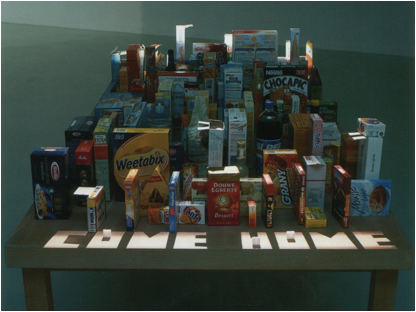
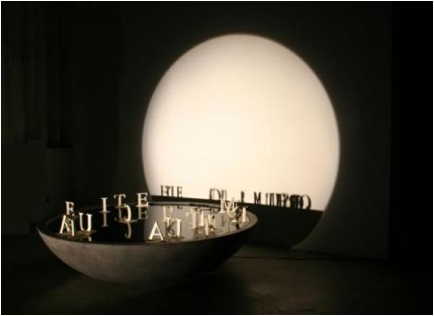
Here are the links to these artists original sites so you can check out their work!
http://rossashton.com/index.html
http://www.fred-eerdekens.be/
Artist Post: Frank Borin and Christian Marclay
The first person I am looking at is Frank Borin. Borin is a director who has directed various commercials, such as Coca Cola, Bud Light, and Abercrombie & Fitch (to name a few), and has helped to shape the careers of various artists such as Eminem, Red Hot Chili Peppers, Backstreet Boys, Natalie Imbruglia, Bowling for Soup, Good Charolot, and Lifehouse (again, to name a few). Borin had the amazing opportunity to gather filmmaking knowledge on sets of directors such as Chris Columbus (Harry Potter), Roland Emmerich (Independence Day), and Robert Zemeckis (Back to the Future). The video I am interested in is Lifehouse’s video “Halfway Gone”. In this video, all the band members are lip-syncing the song as well as various other people. It shows multiple people singing this song at the same spot within a few seconds. This is the aspect that I am most interested in because it pertains the most to what I would like to do for my final project. This video also shows people seemingly appearing out of nowhere, which I definitely think is a, quite simply, cool aspect and will perhaps look into how that is done at a later date.
I found more concepts that I have similar ideas to in some of Borin’s other videos. For example, in Bowling for Soup’s “1985” video, it has the band switching outfits as the song progresses giving the impression of switching scenes. I will be switching my visual but keeping along with the song in the same way the band is continuously keeping with the song despite the change in ‘scenes’. I want to accomplish this idea using a variety of different scenes from movies, shows, music videos, and whatever else I can get my hands on.
The second person I am writing about is Christian Marclay. Marclay is a visual artist and composer, whose work likes to travel among connections of sound, noise, photography, video, and film. In 2011, “Marclay was recognized as the best artist in the official exhibition, winning the Golden Lion for The Clock…” (Wikipedia). The Clock video is exactly what I am going to discuss. In this video, Marclay puts the video together using scenes from various movies and shows that have a clock within a scene and edits the various videos so that a clock (time) connects the scenes by connecting the clocks. While I probably won’t have such smooth transitions between my scenes, this was definitely an interesting artist to look at because the basis of my project is similar. The idea that I will be jumping from one scene from one place to another is practically the same, which is why this was a valuable artist to look at for my project this time.
My project will take a song and have people from various forms of film be “singing” the song. I have a few options that I can explore, but I definitely draw inspiration from Frank Borin and Christian Marclay as well as a few other artists that I found on YouTube.
http://en.wikipedia.org/wiki/Halfway_Gone
http://frankborin.4ormat.com/biography
http://en.wikipedia.org/wiki/Christian_Marclay
Indonesian Video Art Response
I liked the Public Participation section at the end of this paper. I’ve found that art and other things can more easily catch attention when an individual can be involved. It also helps to get word out because we can follow the theory that if one person tells two people, and those two people tell two more people (each), and so on and so forth, many people know about your piece. Also, within the people who know there is bound to be some that become enthusiastic about your piece. Having public participation can be a double-edged sword though. An artist (who has an interactive piece) almost always has an audience that will purely be an observer or only participate. When creating an artwork though, an artist generally has an idea of what their work means, which might mean that in order to get the message across, it might be necessary to interact with it. Or it might be necessary to see it from afar. With that though, I assume the artist assumes that everyone will either observe or interact. An artist does not know how an interactive piece will go until it is happening; an example is what Marshall McLuhan writes,
“…when a camera is in the hands of high school students (Jakarta), it quickly becomes a tool to be critical of the discriminatory rules being applied in their schools. On the other hand, it can show an honest self-criticism through documentaries of students busily using their cell-phones when their teachers are trying to present lessons” (McLuhan 258).
This proves the point that depending on who is interacting with the art can decide how the art is interpreted. This is an important concept to understand for projects such as the projection project that the class is currently working on.
Peter Osborne and Hito Steyerl:
I had a difficult time finding additional information on Peter Osborne, but I enjoyed his piece Distracted Reception: Time, Art and Technology. Osborne talks quite a bit of “distraction” and rightfully so. “Distraction” might be the word of the century; with computers, phones, games, television, and more, we are in a constant state of distraction. Being consistently surrounded by social media everywhere we go does not allow us to focus on one thing at a time. I find Osborne to be claiming in this paper that these similar objects (computer, phones, film, photos and more) are conventional for us, but not yet artistic.
Osborne claims that, “In today’s context of a renewed—and newly historical—interest in film and video in art spaces, ‘the sort of distraction provided by art’, and ‘the new tasks of apperception’ to which it attests, are at issue once more” (Osborne 67). I found this statement to be very important because we currently have serious issues of schools cutting down art programs and the general public does not see art anymore, instead they look at what is useful or what is useless. The impact of the design of something is breaking down to how thin or how small the object is (computers, phones, televisions). Osborne makes a point and states that, “Technologies that were once artistically avant-garde (like video) are now commonplace, while the obsolescent commonplaces of the recent past (such as 16mm film) are being artistically revived by a backward-looking avant-garde in search of more opaque, less immediately received, artistic materials” (Osborn 67). I take Osborne to be making a point that people don’t respect or acknowledge new forms of art, but instead artists need to use outdated materials in order to gain respect for their artwork. (NOTE: This is just my opinion, I do not mean to say that this is always the case, however based on the context of Osborne, this is what I got out of it).
Artwork is seen as a distraction and viewers are looking for a distraction. “Art distracts and art is received in distraction…[w]e go to the gallery, in part, to be distracted from the cares and worries of the world. To be so distracted, we must attend to the artworks on display. Yet, once there, the kind of attention demanded by the works (and by the institutional context)—contemplative immersion—can produce an anxiety that itself generates a need for distractions” (Osborne 68). Yet, the public does not wish to necessarily be distracted. It appears to be a constant struggle of the art world because we live in such a fast paced world that people believe they cannot afford to be distracted, and yet they yearn to be distracted all at once. A nice question that Osborne asks is, “How is art to be received in distraction without becoming simply another distraction?” (Osborne 69). I do not know the answer but I believe that these are issues that will continue to exist for time to come.
(No artwork could be found for Osborne)
I liked the interview of Hito Steyerl even more than Osborne’s piece. Steyerl is a female filmmaker and author. What really got my attention was right at the beginning when answering the first question: “One of the biggest misunderstandings about digital information is that it is replicated identically without loss or transformation. But anyone who works with such information knows that digital practice is constituted – like perhaps any technology – by malfunction” (Steyerl). This is as true as the sky being blue. I have run across this when writing programs and you can go back in history and find more than technological things that were accidents (bubblegum, insulin, and more!). When we can turn imperfections into successes, those of us who work with the digital world are amazed. The public may believe that the ‘accidents’ were decisions purposely made, and they are right to a degree; once the accident happens, artists have the decision to fix it or not. Sometimes it is more interesting to keep a mistake and make it a highlight of a project. Glitches always have potential, but depending on the project depends on whether the glitch is a good or a bad thing. I was intrigued by the whole interview, and I would highly suggest reading it all the way through.

